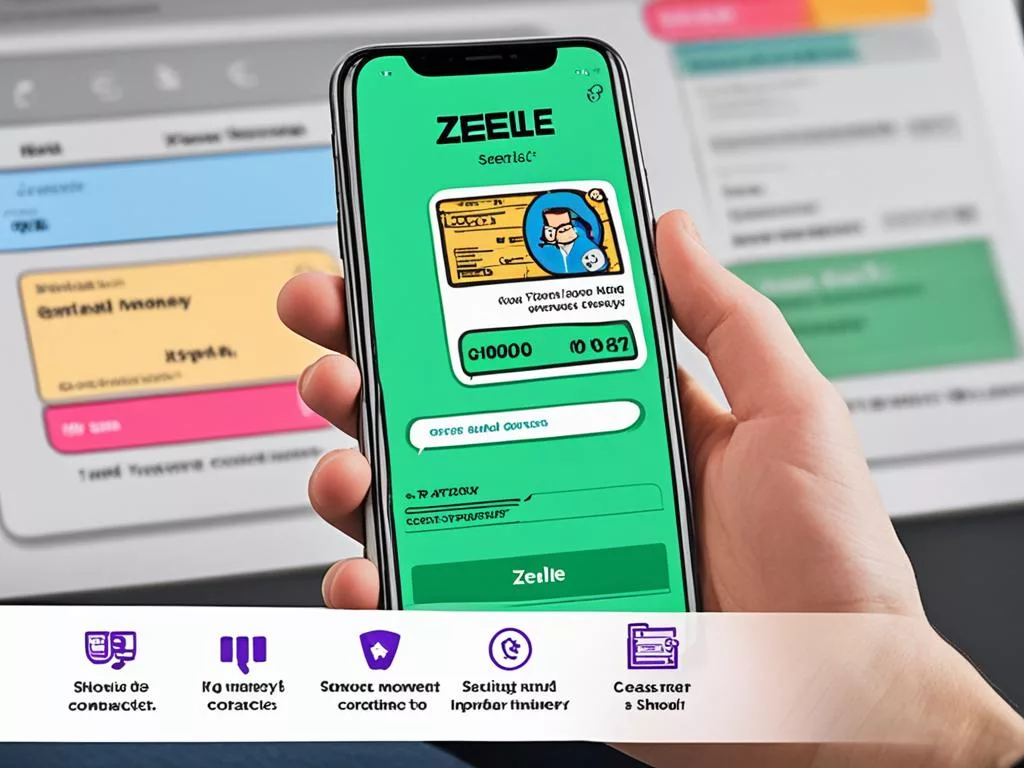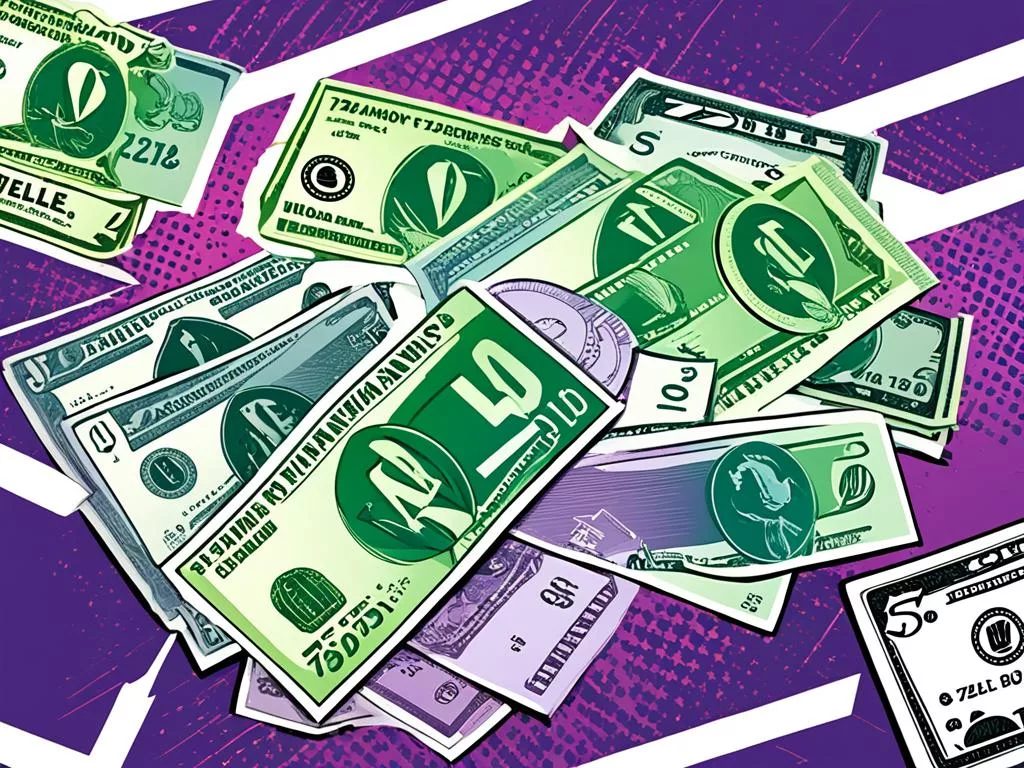There’s a quiet thrill that comes with sending money across the digital expanse, a seamless transition of funds that seemingly defies both time and space. I recall the first time I used Zelle, the simplicity of the Zelle payment procedure unfolded before me as dollars danced swiftly from my account into my friend’s with a few easy taps. It felt like a glimpse into a future where currency flowed as freely as words in a conversation. With the pace of today’s world, we yearn for the swiftness and certainty Zelle provides, but along with the benefits, there are frameworks we must adhere to. While Zelle money transfer steps are generally straightforward, a crucial part of learning how does Zelle work and what are the transfer limits is familiarizing oneself with the boundaries set by our financial institutions. For example, if using Zelle independently of a partnered bank, users are subject to a maximum of sending 500 USD and the possibility of receiving up to 5,000 USD within a week1. Meanwhile, various banks weave their own tapestry of rules, like Wells Fargo, which ties sending limits to account types and online banking history, yet graciously imposes no cap on incoming funds1.
It’s essential to navigate these transfer limits with care; they are in place not just to safeguard the financial system but to remind us that even in this era of instant gratification, some boundaries remain. And should our financial ambitions outstrip the generous ceilings of up to 3,500 USD per day lent by financial giants like Bank of America, we must seek alternate avenues, perhaps considering platforms like Wise for higher transfer needs1. In this tapestry of technology and regulations, the Zelle payment procedure remains a powerful tool, marrying convenience with responsibility—encouraging us to move money thoughtfully, within the realms of assurance and trust that our banks strive to construct and maintain for us all.
Introduction to Zelle: An Overview of the Fast and Fee-Free Payment Network
In my exploration of modern financial services, I’ve witnessed firsthand the growth of Zelle, a fast and efficient fee-free payment network. Serving a dual role, Zelle facilitates monetary exchanges with the ease of a traditional banking system while pushing the envelope in speed and convenience. Unlike other services that can delay transfers with tedious processing times, the Zelle transfer process boasts an almost immediate transfer of funds, radically transforming the way we handle personal finances.
The year 2021 saw an astonishing $490 billion flow through Zelle’s digital channels, emphasizing the network’s scalability and reliability to manage a high volume of transactions. This intricate dance of digits from one account to another is not only swift but also deftly evades the service fees that often accompany such transfers. Now, embracing the role of an adept financial navigator, let’s delve into the nitty-gritty of Zelle’s transaction limits and Zelle payment cap that define this landscape.
As diverse as the banks it partners with, Zelle’s transaction limits invite a closer look. Join me as we list these limits in the table below, ensuring clarity in what can seem like a labyrinth of numbers and rules. A user’s transfer capacity using Zelle is inherently tied to their bank’s policies, and understanding this is paramount to leveraging the service to its full potential.
| Bank | Daily Transaction Limit | Weekly Transaction Limit |
|---|---|---|
| Bank A | $2,000 | $5,000 |
| Bank B | $2,500 | $10,000 |
| Bank C | $1,000 | $4,000 |
While the above table offers a simplified glance, it’s reflective of the broader tapestry that Zelle weaves across the financial landscape. Knowing your bank’s specific
My parting advice to those treading the digital highways of Zelle’s network? Keep the gears of your financial undertakings well-oiled by staying informed about these vital features of the Zelle transfer process, and ensure that you never miss a beat in this ever-quickening realm of digital payments.
How Does Zelle Work and What are the Transfer Limits?

When dealing with Zelle transfer restrictions, it’s essential to recognize the boundaries each financial institution sets for its users. Bank of America, Wells Fargo, and Chase, being part of the 10,000-strong network of banks and credit unions that embraced Zelle by 2021, provide clear examples of such Zelle transaction boundaries2. Bank of America allows up to $3,500 to be transferred daily, while Chase limits single transactions and daily totals to $2,000 for personal checking account holders. Wells Fargo matches the daily cap set by Bank of America at $3,500 for established customers.
Zelle transaction boundaries stand as a crucial aspect of sending and receiving funds, particularly due to Zelle’s immediate settlement of transfers3. Users should note the weekly cap of $500 for transactions via Zelle’s app when their bank isn’t a Zelle partner2. While Zelle’s system is engineered for speedy, fee-free transactions across almost all major bank institutions, this convenience comes with the caveat that, unlike credit cards, Zelle transfer rules advise transactions only with individuals who are known and trusted.
Regarding Zelle transfer rules, I have found the following integrated banking limits from data that gives us a snapshot of the varied constraints associated with different banks as of 2021 and 2019:
| Financial Institution | Daily Transfer Limit | Monthly Transfer Limit |
|---|---|---|
| Bank of America | $3,5002 | $20,0003 |
| Chase Personal Checking | $2,0002 | $16,0003 |
| Wells Fargo | $3,5002 | $20,0003 |
| Ally Bank | $5,0003 | $10,0003 |
While Zelle’s integration within the mobile banking apps of many major banks facilitates ease of use, being mindful of Zelle’s transfer restrictions is imperative. This ensures that our transactions remain within the prescribed Zelle transaction boundaries and abide by the governing Zelle transfer rules3. As users continue to enjoy the quick and generally secure transfer service Zelle offers, it’s always wise to verify recipient information diligently, as Zelle transactions complete within minutes and are irreversible once initiated3.
The Nuts and Bolts of Zelle: Setting Up and Transacting
Embarking on the Zelle payment procedure is a streamlined experience for the umpteen customers looking to facilitate cashless transactions swiftly. My firsthand familiarity with the setup begins by choosing whether to enroll through my bank’s mobile application or directly via the Zelle app, should my bank not be a participating entity. Zelle prides itself on effortless integration, successfully catering to approximately 67 million consumer and small business customers in the United States alone4.
When engaging in Zelle money transfer steps, I’m pleasantly relieved to enter merely the email address or U.S. mobile number of my trusted recipient—the cornerstone of its user-centric design. With a surging user base, estimated to have hit 61.1 million in 20224, Zelle’s universal adoption speaks volumes about its efficacy and reliability in real-time funds transfer.

Nonetheless, I stay updated with the challenges that accompany such growth and technological convenience. Reports of increased scam incidents associated with Zelle transactions prompt me to exercise greater vigilance. It became known that 66% of user reports about problems at Bank of America indicated issues with “funds transfer”, emphasizing the need for rigorous security checks and awareness4. With industry giants like Bank of America, part-owner of Zelle’s Early Warning Services, LLC, alongside JPMorgan Chase and others, facing criticism for not adequately safeguarding customers against fraud4, the pressure mounts to bolster the platform’s defenses—affecting both my peace of mind and transactional choices.
Despite potential pitfalls, my confidence in Zelle doesn’t wane, thanks to the commitment from the likes of Senator Elizabeth Warren demanding immediate fixes and compensation for wronged customers4. As Zelle strives to stay at the pinnacle of P2P payment options, they must navigate through complex landscapes, including addressing public critique and refining their service to repel fraudulent activities more effectively. As a user, my trust lies as much in their technological proficiencies as their ethical responses to crises and customer satisfaction.
In conclusion, embracing the Zelle money transfer steps equips me with a powerful tool for managing my finances. However, it comes with an advisory note of caution, reminding me to transfer funds judiciously amongst familiar faces and verified small businesses, vital for maintaining financial security and trust in this digital age.
Exploring Zelle’s Transfer Rules and Safety Protocols
When it comes to sending and receiving money through Zelle, understanding the Zelle transaction limits set by various financial institutions is essential for efficient financial planning. At Ally Bank, for instance, users can initiate instant transfers of up to $2,000, schedule up to $5,000, and need not worry about exceeding a generous monthly cap of $10,0005. Meanwhile, Bank of America customers benefit from a daily limit of $3,500 and an even higher monthly threshold of $20,000 for Zelle transactions5. Each bank, including Chase with a flexible daily limit up to $10,000, tailors their Zelle transfer rules to meet their customers’ needs and maintain secure transactional boundaries5.
An understanding of Zelle transfer restrictions also requires recognition of Zelle’s commitment to safety, where methods such as data encryption and multifactor authentication act as gatekeepers for transaction security5. The Zelle network emphasizes that its service is solely for personal transfers amongst friends, family, or trusted acquaintances, with a firm age requirement of 18 years old for usage6. This delimits the service from business or commercial use, which aligns with Zelle’s framework focusing on personal financial exchanges6.

Furthermore, Zelle’s design for ease and immediacy in money transfers is supported by the fact that transactions between enrolled customers typically occur within minutes – a stark contrast to the traditional multi-day waiting periods7. It’s also important for senders to verify recipient information meticulously, as canceling a Zelle payment is often only feasible if the recipient hasn’t yet registered for the service7. For Zelle users enrolled through U.S. Bank, the comfort of both sending and receiving money without fees is available, although it’s decisive to report any concerns regarding unusual account activities swiftly to U.S. Bank’s Fraud Liaison Center7.
Delving into these transactional nuances, the following table provides a clear comparison of limits and fees across various banking institutions, encapsulating the diverse landscape within which Zelle operates:
| Financial Institution | Instant Transfer Limit | Scheduled Transfer Limit | Monthly Limit | Fees |
|---|---|---|---|---|
| Ally Bank | $2,000 | $5,000 | $10,000 | No fees for Zelle |
| Bank of America | N/A | N/A | $20,000 | No fees for Zelle |
| Chase Bank | Up to $10,000 | N/A | Varies | No fees for Zelle |
| Wells Fargo | N/A | N/A | $20,000 | No fees for Zelle |
| TD Bank | $1,000 | $2,500 | $10,000 | No fees for Zelle |
| USAA Federal Savings Bank | $1,000 | N/A | $10,000 | No fees for Zelle |
Through this analysis, it’s evident how critical it is for users to familiarize themselves with the specific Zelle parameters offered by their financial institution and to exercise caution by leveraging Zelle’s safety protocols for a secure and satisfactory money transfer experience.
Zelle Transaction Boundaries: Demystifying Transfer Caps

Navigating through Zelle transaction boundaries can be intricate, as Zelle transfer limits are not universal. To understand the Zelle payment cap, one must consider the individual policies of each financial institution. For instance, Ally Bank accommodates instant transfers up to $2,000 and scheduled transfers up to $5,000, subject to a $10,000 monthly limit5. This showcases flexibility within Zelle’s framework, supporting both immediate and planned transactions. On the higher end of the spectrum, Bank of America endorses daily transfers up to $3,500, capping the monthly limit at a generous $20,0005.
Contrasting these numbers, Chase Bank presents a variable range from $500 to $10,000 per transaction, which informs users that their Zelle payment cap might fluctuate based on factors Chase does not publicly disclose5. Further unique to the individual banks is the offering of Citibank, which imposes a daily transfer limit of $2,500 with a monthly fencing of $15,000 for certain accounts5. It’s clear that Zelle transfer limits are tailored to the diverse needs of bank clients, necessitating a close review of one’s bank policies before initiating transactions.
Interestingly, financial conduits like Discover Bank and Quontic Bank set lower daily limits—$600 and $500 respectively—yet, they don’t openly state their monthly limits5. This opacity in Zelle transfer limits indicates the importance of consultative engagement with one’s bank for precise, up-to-date information on Zelle transaction boundaries.
Amid this variability, Zelle maintains its appeal as a fee-free alternative to services like Venmo and Cash App, which charge up to 1.75% for instant transfers5. The cost-effectiveness of Zelle coupled with its heightened security measures, like data encryption and multifactor authentication, clearly positions it as a savvy choice for consumers in spite of the ever-present fraud risks associated with sharing personal information5.
| Bank | Daily Limit | Monthly Limit | Instant/Scheduled Transactions |
|---|---|---|---|
| Ally Bank | Up to $2,000 (Instant) | $10,000 | $2,000 (Instant) / $5,000 (Scheduled) |
| Bank of America | $3,500 | $20,000 | Not Specified |
| Chase Bank | $500 to $10,000 | Not Disclosed | Varies |
| Citibank | $2,500 | $15,000 | Not Specified |
Despite Zelle transfer limits imposed by individual banks, Zelle itself, through the standalone app, offers up to $500 weekly for sending funds, a structure many might find limiting compared to the capacious bounds of services like PayPal or Apple Cash, which permit significantly higher transfers8. Acknowledging these Zelle transaction boundaries is crucial, as they can significantly influence how one orchestrates personal finance management and larger peer-to-peer transactions.
Zelle for Business and Personal Use: Adapting to User Needs
As I delve into the intricacies of Zelle’s payment procedure, I’m captivated by its adaptability, catering to both individuals and small businesses with ease. In my experience, individuals laud Zelle for its swift and straightforward money transfer steps, perfect for settling bills with friends or compensating service providers. In 2021, the robust Zelle network facilitated an astounding $490 billion over 1.8 billion transactions, showcasing its wide acceptance and reliability2. Meanwhile, small businesses gravitate towards Zelle for small business, harnessing the platform’s ability to enhance cash flow promptly without any accompanying fees.
Understanding the Zelle transfer limits is imperative for maximizing its utility. For instance, Bank of America endorses a daily limit of $3,500 for its customers, whereas Chase offers a generous $2,000 per transaction limit for personal checking account holders and up to $5,000 per day for private client or business checking accounts, indicating the platform’s flexibility21. Notably, if customers find themselves at institutions outside the nearly 10,000 banks and credit unions in the Zelle network, they can still initiate weekly payments up to $500 using the Zelle app2.
Conversely, Wells Fargo establishes customer sending limits based on their account type and historical online banking activity, although there is no cap on receiving funds via Zelle, making it an open channel for incoming payments1. This serves as a reminder that while Zelle’s framework is designed for reliability and speed, trust is a cornerstone of its operation. The platform provides a seamless money transfer avenue free of the broader consumer protections found in credit transactions, underscoring the necessity to transact with known and verified recipients.
Source Links
- https://wise.com/us/blog/zelle-transfer-limits
- https://www.forbes.com/advisor/money-transfer/what-is-zelle-how-does-it-work/
- https://www.experian.com/blogs/ask-experian/heres-what-you-need-to-know-about-zelle-the-mobile-payment-app-that-rivals-venmo/
- https://abc7chicago.com/bank-of-america-glitch-issues-today-missing-money/12716035/
- https://www.bankrate.com/banking/zelle-limits-at-top-banks/
- https://www.capitalone.com/bank/disclosures/zelle/
- https://www.usbank.com/online-mobile-banking/zelle-person-to-person-payments.html
- https://www.bankrate.com/banking/best-ways-to-send-money/

